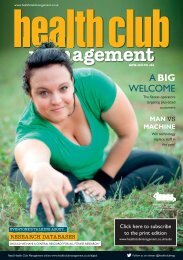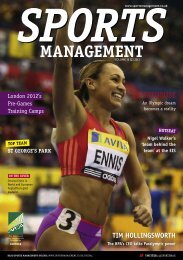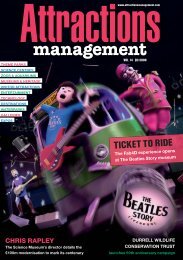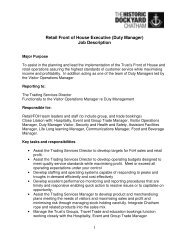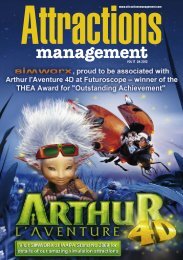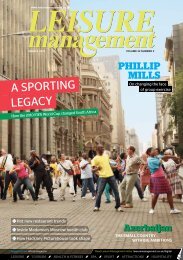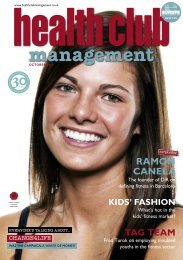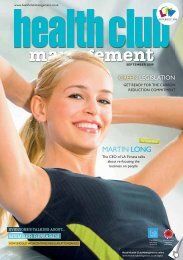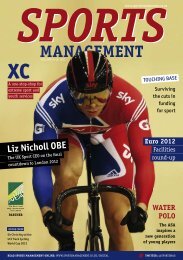BIGambitionstry petanque’ and a Brazilian ju jitsu openday. The inaugural event is supportedby ClubSportEdinburgh, an independentbody which is the collective voice ofsports clubs in the city – and an organisationwhich has also rebranded itself inthe past couple of years.The city’sageing RoyalCommonwealthPool will receivea £37m redesign(above).FINDING FACILITIESEdinburgh does not lack open spaces to host such kind ofevents, but when the council steering group evaluated sportsfacility provision back in 2003, it came up with a mixed picture.Swimming pool provision was found to be “excellent” and inareas such as the port of Leith there was even thought to bean oversupply. However, many of these older facilities were in arundown state, and a capital investment budget was ringfencedfor facility renewal. Projects range from straightforward leisurecentre refurbishments to grander projects. Harris says work willstart in August on the ageing Royal Commonwealth pool, whichis a national facility for Scotland. The £37m redevelopment – toinclude a 50m pool and new diving facility that will be used forthe Glasgow Commonwealth Games in 2014 – will produce asparkling new facility in two years time.A £5m, 18-month refurbishment is also underway at theGlenogle Swim Centre in Stockbridge, part of a wider councilstrategy to preserve all the city’s historic Victorian baths. TheSUPPORTING SCOTLAND’S AIMSThe Physical Activity andHealth Alliance (paha.org.uk)is an online community websitebringing together thoseinvolved in the promotion ofphysical activity in Scotland,whether from the health, leisure,voluntary or privatesector. Members can accesskey national strategy documentsand current researchrelated to physical activity,and are encouraged to contributeand share informationwith each other through theonline forum.revamped Victorian pool will reopen in spring 2010.When the council examined sportshall provision in the city,the picture was not so rosy. It estimated that only 34 per centof demand was being satisfied by existing non-school-basedprovision. A way to boost this, it decided, would be to open uplarger public school halls to the public – which could then satisfyan estimated 77 per cent of demand. Harris says work inthis area is “ongoing”, and through public/private partnershipschemes many school halls are being upgraded and opened up– thus improving reach in the city’s more under-resourced areas.A somewhat controversial project is the city’s MeadowbankStadium - a large-scale multi-purpose sports complex builtwhen Edinburgh first hosted the Commonwealth Gamesin 1970. There were plans formed in 2006 to demolishMeadowbank, sell off the land and use the funds to build aSCOTLAND’S HEALTHhe Scottish Health Survey 2003looked at 8,148 adults and 3,324T children, and found the following: The proportions of men and womenaged 16-74 who were meeting physicalactivity requirements (30 minutesof activity on most days) increasedfrom 41 per cent in 1998 to 44 per centin 2003 in men, and from 30 per cent in1998 to 33 per cent in 2003 in women.Increases in physical activity participationwere especially marked for menand women aged 55-74. 65 per cent of men and 60 per cent ofwomen were either overweight (BMI25-30) or obese (BMI 30-plus). Theproportion of adults who were eitheroverweight or obese increased significantlybetween 1995 and 2003, from56 per cent to 64 per cent in men,and from 47 per cent to 57 per cent inwomen. The proportion of people whowere morbidly obese more than doubledin this time. 39 per cent of men and 35 per centof women spent an average of fouror more hours sitting at a screen perweekday (this increased at weekends). 74 per cent of boys and 63 per centof girls aged 2-15 had a high physicalactivity level (at least 60 minutes, sevendays a week). 12 per cent of boys and18 per cent of girls had medium levels(30-59 minutes, seven days a week),while 13 per cent of boys and 19 percent of girls had a low activity level(0-30 minutes, on seven days a week).School activities were not included.Activity levels declined with age amonggirls aged 8-10, but not among boys. The most common activities reportedby children were: walking (boys 92per cent, girls 94 per cent); active play(boys 91 per cent, girls 88 per cent);and sports and exercise (73 per centboys, 68 per cent girls). 32 per cent of boys and 24 per cent ofgirls aged 13-15 spent on average fouror more hours a day sitting at a screen(TV, computer or video game). Therewas an increase in the prevalence ofobesity in boys between 1998-2003(from 29 per cent to 35 per cent), butno change for girls (30 per cent).40 Read <strong>Leisure</strong> Management online leisuremanagement.co.uk/digitalISSUE 3 <strong>2009</strong> © cybertrek <strong>2009</strong>
The Primary School Sport Challengesmaller facility in the east of thecity. However, this has been met bywidespread opposition from localcampaign groups. According toHarris, the project is currently on holddue to the economic climate”.GROWTH IN VISITSWorking on delivering much of thephysical activity agenda is Edinburgh<strong>Leisure</strong> – a not-for-profit companySCOTLAND’S TARGETSThe ScottishGovernment’s targetsto increasephysical activity are:to achieve 50 percent of all adultsaged over 16, and80 per cent of childrenaged 16 andwhich receives £9m a year (towards a total leisure spend of over£24m) to run the council’s 31 leisure venues. The company’sAllison Brodie says leisure visits are showing steady growth. In2002/3, there were 3.6 million annual visits to leisure centres inEdinburgh, which has a population of over 450,000. That figure iscurrently 4.1m, and the 2008/09 revenue of £16.2m from leisurevisits represents a six per cent increase on the previous year.The company now operates many targeted schemes aimedat bringing specific populations in touch with a healthier lifestyle.One, Edinburgh’s Young Sports Ambassadors, a firstfor Scotland, has seen 11 young sporting ambassadorspicked from Edinburgh schools to give young people a voiceand develop new sport and activity programmes for youth.Edinburgh <strong>Leisure</strong> also operates the BAA Youth Games, whichhas grown year on year over the past decade; this year’s eventsaw 1,600 partipants from schools across the city.For older residents unable to access services, Edinburgh<strong>Leisure</strong> brings activities to care and nursing homes. For mothersdiagnosed with post-natal depression, a scheme deliveredalongside health partners gives them access to discounted leisurefacilities and fully-funded creche places.GETTING THE MESSAGE ACROSSGoing forward, Harris says the council is looking to do morework with the Lothian NHS Trust. This work is really aboutunder, to meet theminimum recommendedlevels by2022. To meet thisgoal, it will needto see averageincreases of one percent a year acrossthe population“health message blitzing’ (posters,leaflets in GP surgeries, busshelter adverts, etc), particularlyin poorer pockets of the citysuch as Craigavon, Craigmillar andMuirhouse, where problems may bemasked by Edinburgh’s generallyperceived affluence. The most basicmessage – as reflected in the UK’sChange 4 Life campaign (just beingpiloted in Scotland) – advises 30 minutesof activity per day for adults and 60 minutes for children.At the time of the government’s White Paper, there were threetimes as many inactive Scots as those who were smokers. “Thedangers of physical inactivity is the most important message toconvey in public health,” says Harris. “People know smokingcan kill, but they don’t necessarily link inactivity to a greater riskof heart disease, colon cancer or mental health problems.”By 2020, the council will not have a definitive way to ‘measure’its results – the process is considered more important thanend results. Harris says one encouraging marker this year hasbeen the city’s 10K race. More than 10,000 runners registeredfor the event, which took place on 3 May – up from 6,000 to7,000 participants last year.For a more detailed health picture, the council is monitoringits achievements in line with the government’s Scottish HealthSurvey, an in-depth look at the health of the nation in privatehouseholds. Surveys took place in 1995, 1998 and 2003. Themost recent study, started in 2008, will be carried out over threeyears, with the first results to be published this summer.As for Edinburgh becoming Europe’s most active city, again,there will be no concrete markers – only, it’s hoped, a growth inreputation. “We think of Amsterdam as a healthy city becauseeverybody cycles, and we want Edinburgh to gain this kind ofreputation,” says Harris. For most in the city – leisure providersand leisure users alike – it will be the taking part that counts. ●ISSUE 3 <strong>2009</strong> © cybertrek <strong>2009</strong>Read <strong>Leisure</strong> Management online leisuremanagement.co.uk/digital 41




